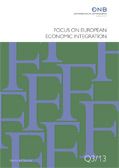Focus on European Economic Integration Q2/14
 OeNB
OeNB
- Erschienen:
- Juni 2014.
 OeNB
OeNB
Call for Entries: Olga Radzyner Award 2014 for Scientific Work on European Economic Integration (PDF, 926 kB) Focus on European Economic Integration Q2/14 en 30.06.2014, 00:00:00
Call for Applications: Visiting Research Program (PDF, 641 kB) Focus on European Economic Integration Q2/14 en 30.06.2014, 00:00:00
Developments in Selected CESEE Countries: Economic Recovery Increasingly Driven by Domestic Demand (PDF, 1,3 MB) en 30.06.2014, 00:00:00
Outlook for Selected CESEE Countries: Moderate but Firming Growth (PDF, 987 kB) en 30.06.2014, 00:00:00
Finance, Potential Output and the Business Cycle: Empirical Evidence from Selected Advanced and CESEE Economies
(PDF, 1,3 MB)
Bernhofer, Fernández-Amador, Gächter, Sindermann.
Bernhofer, Fernández-Amador, Gächter, Sindermann – Focus on European Economic Integration Q2/14
Traditional approaches to separate the underlying trend of potential output from cyclical developments mostly rely on the concept of nonaccelerating inflation output and are thus unable to detect upswings caused by the financial cycle, which often appear to be unsustainable in the long run. In this study, we therefore propose to extend the structural unobserved components model developed by Harvey (1989) and Harvey and Jaeger (1993) by including information on the financial cycle, i.e. private credit and house price developments, to explain the cyclical deviations from potential GDP. Thus, we are able to calculate “finance-neutral” potential output and corresponding “finance-augmented” output gaps, which take the effect of financial variables into account. We apply this novel concept to four advanced economies (AT, IE, NL, US) and four economies in Central, Eastern and Southeastern Europe (BG, EE, PL, SK) in a comparative manner. Our results show a considerable impact of the financial cycle on business cycle developments in most of the economies under review, both advanced and emerging.
Remarkably, our finance-augmented output gaps exhibit a considerably higher explanatory
power for the variation of observed unemployment rates in corresponding economies than
standard approaches (such as the HP filter). In other words, our results considerably strengthen the case for considering the financial sector in business cycle measurement.
en
financial cycle, potential output, business cycles, output gap, emerging markets, finance-neutral potential output, finance-augmented output gaps
E10, E32, E44, E47, E52, G01
30.06.2014, 00:00:00
How Did CESEE Households Weather the Crisis? Evidence from the OeNB Euro Survey (PDF, 1,5 MB) Corti, Scheiber. Corti, Scheiber – Focus on European Economic Integration Q2/14 During the crisis period from 2008 to 2013 household disposable income deteriorated significantly in Central, Eastern and Southeastern Europe (CESEE), forcing households to adjust their consumption plans. Against this background, the present paper sheds some light on households’ consumption smoothing behavior based on microdata supplied by the OeNB Euro Survey for ten countries in CESEE. We find that households reacted to stagnating and in some countries falling income mostly by cutting back on everyday consumption and reducing or postponing large expenditures, while other households coped by reducing the amounts they were setting aside as savings or by drawing on existing savings, overdrawing their current accounts and increasing work hours. Moreover, we find that macroeconomic forecasts by the European Commission, the wiiw and the OeNB are broadly in line with economic sentiment among CESEE households. Finally, Euro Survey results revealed that not all households were able to borrow as much as they would have liked to and that the share of households planning to take out a loan fell between 2008 and 2013. en economic and financial crisis, consumption smoothing, household debt, survey data, Central, Eastern and Southeastern Europe D12, D14, E21, G01 30.06.2014, 00:00:00
CESEE-Related Abstracts from Other OeNB Publications (PDF, 698 kB) Focus on European Economic Integration Q2/14 en 30.06.2014, 00:00:00
75th Anniversary East Jour Fixe on “Ten Years After the 2004 EU Enlargement: Achievements and Next Steps” (PDF, 1,2 MB) Focus on European Economic Integration Q2/14 en 30.06.2014, 00:00:00
IMF Spring 2014 “Regional Economic Issues” Report for CESEE Recommends: Safeguarding the Recovery as the Global Liquidity Tide Recedes (PDF, 1,2 MB) Focus on European Economic Integration Q2/14 en 30.06.2014, 00:00:00
Statistical Annex (PDF, 570 kB) Focus on European Economic Integration Q2/14 en 30.06.2014, 00:00:00
Notes (PDF, 271 kB) en 30.06.2014, 00:00:00